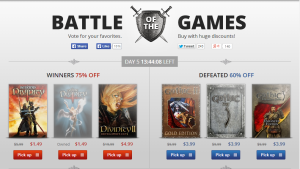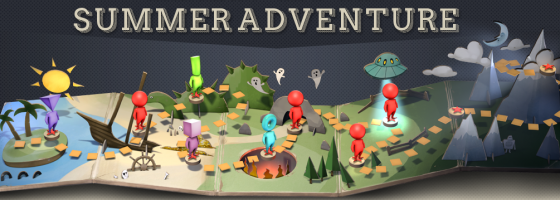Recently I interviewed game designer Jeff Vogel about his thoughts on the industry and design. One of his recent blog posts was on what he felt was the bubble bursting for the Indie market. Basically as more people develop cheaper games, we are reaching a point of overload with too many cheap games being released and not enough money going around for a profit.
I’ve talked about the devaluing of games in the past and I’m starting to wonder if there is a case for too much of a good thing in the Game Industry.
The Backlog of Doom:
The last five years or so have been marked by an explosion of new game designers and companies from the Indie sector. It’s gotten to the point between indie, mobile, social and AAA developers that we can’t go a week without a new game being released on the market. Contrast that to the old days of the 80s and 90s where maybe only three or four games a month would be released and the number of quality games was even smaller.
Throw in crowdfunding and kickstarter and you can get enough investor capital to make a game on your own without the backing of a publisher. What that basically means is that the number of games being released has skyrocketed, but the amount of money available hasn’t. Despite the Game Industry growth, we are still in a horrible economy (at least in the US) and money is tight.
The combination of the economy and the sheer volume of games have created this sales mentality that has taken over. We are conditioned now to wait for game sales on all but the most desirable games and the average price for a game has dropped.

Game sales are giving people more games to played at a lower cost which is great for now but not so much for getting them to buy more games in the future.
On my podcast with the guys from Digital Eel, once I was spending $40 to $50 on a new game regularly.
Today, it takes a hell of a lot of effort for me to spend $15 or more on a new game, much less $60 for an AAA title. And when these big sales come around, I’ll probably blow $150 on anywhere from 20 to 40 video games and that’s it for several months.
And this has given me and other gamers a huge backlog of games to play. I recently stared at my Steam library and looked at all the games I’ve yet to play.
At this point, I must have at least 700 hours easily and I’m not even counting all the classic games I bought on GOG. Think about that for a second, I have enough games to play that it would take me over a month of nonstop playing to get through.
I’m willing to bet that some of you reading this right now are in the same position. A vast majority of us could easily go several months without having to buy any new games and we would have plenty of things to keep us busy. And this backlog of games is one of the key reasons why the industry is being devalued.
Why should I spend $60 on a brand new game when I can just play through all my other games and wait for a sale? We’re not desperate for new games anymore and this has changed the market which some fear is for the worse.
Big Budgets, Low Profits:
This focus on sales is also affected game design from all corners of the market. Spending millions of dollars and years of development on one game is very risky these days. As even if your game is of high quality and gets great reviews, that doesn’t mean people will have the money to spend $20, $30 or more on it. And what happens if you budget your development on making the money back with those initial sales?
The answer is that you’re going to go under before you can recoup the cost. On the mobile market especially, you can’t release expensive games on it when other people are releasing 99 cent titles. The idea that spending 99 cents on one game would be considered a lot for some people is another shocking concept for older gamers.

Bethesda’s recent failure to hit it big with the Elder Scrolls Online is not good given the amount of money they spent and the fact that a major brand failed.
While sales are helping developers make money, it does take a lot more time to recoup that cost. And if you spent a lot of money to make a game, it may come too late.
Over last year speaking to Chris Park from Arcen Games, he talked about how betting the farm on large projects almost bankrupted the studio. While they were making money back gradually, it wasn’t coming anywhere near what they were spending on development. A Valley Without Wind if I remember right was their most expensive game to make both in terms of money and time and it bombed.
If Chris stuck with Valley and continue to put more work into making it profitable, maybe after enough sales they would break even on it. But that could easily take months or quite possibly years for that to happen. And many of us don’t have years of money saved up to sustain us for the meantime. And it’s also important to mention that breaking even on a project doesn’t do a business good in terms of staying afloat.
Unsustainable Sales:
The problem with sales and making your money back through them is that not every game and company can be sustained this way. The social games from King for example, I’m willing to bet that they did not spend anywhere near as much money on development that Paradox did on their grand strategy titles. Or the vast majority of simple Indie titles that start at $5 or less, these games are fun for short diversions but again weren’t developed in the same capacity as Mass Effect.
Recently the problems with Puppy Games was made known and how even though they sold a lot of copies, the price was too low for them to make a profit and sustain themselves.
What’s happening is that the market is bottoming out for major game projects in favor of creating those that are cheap enough that the money can be made back via sales. At the rate we’re going, I doubt we will see anyone crazy enough to release a game on the Indie market at $40 or more. As no Indie developer would have the funds to sustain themselves over a long development period followed by waiting for the profit to trickle in.

The Last Federation was Arcen Game’s first game to be a massive success since AI Wars and was something that they really needed.
And that is key culprit as to why AAA developers are so risk adverse today, they don’t want to wait a year or two to get back the money they put into their titles.
The overhead of working at a major studio is huge compared to an Indie space. Imagine if the next game from Bethesda or Rockstar completely fails and hundreds of millions of dollars are gone, do you think they would still be in business by the end of the year?
We’ve been talking now for months about how another Game Industry shakeup is on its way. But thinking about it more, it’s hard to tell if we’re going to see it from the AAA side, or the Indie side.


